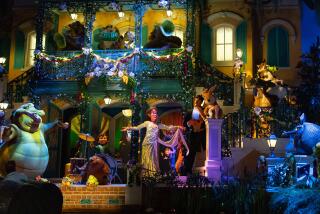What a Long, Strange Trip It Is
Not only did director Nick Willing want his version of “Alice in Wonderland” to be as faithful to the classic Lewis Carroll book as possible, he also wanted it to be a celebration of the various artists who have been influenced by the British author’s work.
In the three-hour spectacular, premiering Sunday on NBC, Willing pays homage to the surreal inventiveness of Terry Gilliam, (“Time Bandits”), the fanciful romanticism of Jean Cocteau (“Beauty and the Beast”) and even the comedies of director Frank Capra (“Mr. Deeds Goes to Town”).
The courtroom scene in which Sir Jack, the Knave of Hearts, is on trial for stealing some tarts, Willing says, is sheer screwball comedy. “It’s like one of those Cary Grant-Katharine Hepburn movies where you have this kind of flustered judge who doesn’t really know what’s going on,” he adds.
“As I read the book and the script, I could see all of this stuff, so I used it all in the film to try and get, if you like, a kind of very rich flavor to the thing with all of these different ingredients, all of them working to one end.”
“Alice in Wonderland” is the latest lavish adaptation of a literary classic from executive producer Robert Halmi--the man behind the popular, special-effects laden “Gulliver’s Travels,” “The Odyssey” and “Merlin.” His son, Robert Halmi Jr. also serves as executive producer.
Tina Majorino (“Waterworld”) stars as the young Alice who is terrified with the prospect of having to sing in front of a group of her parents’ snobby houseguests. Until, that is, a certain white rabbit crosses her path and Alice’s dreamlike adventure begins.
Also on hand in the all-star cast is Whoopi Goldberg as the Cheshire Cat and Gene Wilder as the Mock Turtle.
Jim Henson’s Creature Shop designed the fanciful creatures and London’s FrameStore supplied the 875 digital effects.
Willing only had 10 weeks of preproduction on “Alice,” which was shot late last summer in England. “I literally sat down for two weeks and brainstormed and tried to think of how the thing was going to look,” he says.
“I wanted each scene to look like a Victorian painting or illustration, so the Mad Hatter’s tea party has a Pre-Raphaelite look. When she first sees the White Rabbit, it looks like a watercolor. The reason for this was because I wanted to create a feeling in the audience of a kind of nostalgia, as if it was a Victorian childhood.”
Willing also spent three or four weeks with an illustrator to get the right look for the creatures. “In the 1860s, cartoons hadn’t been invented,” he explains. “I sat with an illustrator designing those characters. Then we did drawings, and they would go to the Henson people who would mold them into clay.”
Once his cast was in place, Willing spent a lot of time discussing Alice with the 14-year-old Majorino.
The director, says Majorino, wanted to keep Alice as realistic as possible. “So that [the Wonderland] characters come across 10 times crazier than they really are,” says Majorino, who thought it was “cool” to play one of literature’s icons.
“We wanted to make sure we kept putting in the whole thing that she is nervous about going to sing,” says Majorino. “So the moral of all of this is to face your fear.”
Because Alice’s fears are such a focal point this version is far darker and scarier than the light, bright animated fantasy assic Walt Disney animated fantasy.
“The way Nick Willing explained is that Wonderland was the place between being a child and being an adult, where everything is completely screwed up. Sometimes you have no idea what is going on, and sometimes it’s a little dark, so he wanted to make it a little more scary, so it just makes her fears realistic.”
Carroll’s book, says Willing, is a strange combination of very frightening and very funny. “Almost everything in the book is never one thing--it’s two things,” he explains.
“In the film I sort of embraced that. It’s not just a forest; it’s also like the inside of a cathedral.”
Visual effects producers Fiona Walkinshaw found Willing to be a very visual director who had clever ideas for each scene.
It was the grinning Cheshire Cat, though, that gave everyone the most grief. “No one would quite imagine it,” says Walkinshaw. “Jim Henson’s Creation Shop built an animatronic body of a cat that was controlled by puppeteers.” That puppet was filmed on location outside or against a blue screen. Then the FrameStore digitally removed the puppeteers from the image.
At the end of the shoot, Willing and an effects supervisor flew to New York and shot Goldberg wearing the cat’s headdress. The footage of her head was digitally fused to the the puppet body.
“Nick wanted Alice to have visual tricks so that every scene you came to you felt like you had gone into different world,” says Walkinshaw.
“Alice in Wonderland” airs Sunday at 8 p.m. on NBC. The network has rated it TV-PG.



